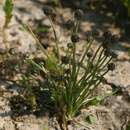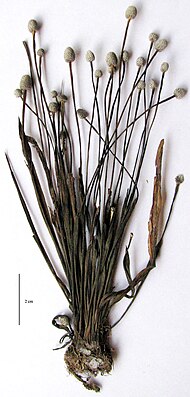en
names in breadcrumbs


Eriocaulon is a genus of about 400 species commonly known as pipeworts, of monocotyledonous flowering plants in the family Eriocaulaceae. The genus is widely distributed, with the centers of diversity for the group occurring in tropical regions, particularly southern Asia and the Americas. A few species extend to temperate regions, with ca. 10 species in the United States, mostly in the southern states from California to Florida, and only two species in Canada; China has 35 species, also mostly southern. Only one species (E. aquaticum) occurs in Europe, where it is confined to the Atlantic Ocean coasts of Scotland and Ireland;[3] this species also occurs in eastern North America and is thought to be a relatively recent natural colonist in Europe. In the Americas, Eriocaulon is the only genus in its family that occurs north of Florida.[4] They tend to be associated with wet soils, many growing in shallow water, in wetlands, or in wet savannas like flatwoods. In wet soils, their abundance appears to be related to water levels, fire frequency, and competition from other plants such as grasses. Experiments have shown that they are weak competitors compared to many other wetland plant species.[5] Some species can persist as buried seeds during unfavorable conditions.[6] The scientific name is derived from Ancient Greek εριον, erion, meaning 'wool', and καυλός, caulos, meaning 'stalk'.[7]
The species are mostly herbaceous perennial plants, though some are annual plants; they resemble plants in the related families Cyperaceae (sedges) and Juncaceae (rushes), and like them, have rather small, wind-pollinated flowers.
Names were sourced from official sources including: the Flora of North America,[8] the Flora of China,[9] currently accepted Australian taxa from the Australian Plant Name Index,[1] etc..

Eriocaulon is a genus of about 400 species commonly known as pipeworts, of monocotyledonous flowering plants in the family Eriocaulaceae. The genus is widely distributed, with the centers of diversity for the group occurring in tropical regions, particularly southern Asia and the Americas. A few species extend to temperate regions, with ca. 10 species in the United States, mostly in the southern states from California to Florida, and only two species in Canada; China has 35 species, also mostly southern. Only one species (E. aquaticum) occurs in Europe, where it is confined to the Atlantic Ocean coasts of Scotland and Ireland; this species also occurs in eastern North America and is thought to be a relatively recent natural colonist in Europe. In the Americas, Eriocaulon is the only genus in its family that occurs north of Florida. They tend to be associated with wet soils, many growing in shallow water, in wetlands, or in wet savannas like flatwoods. In wet soils, their abundance appears to be related to water levels, fire frequency, and competition from other plants such as grasses. Experiments have shown that they are weak competitors compared to many other wetland plant species. Some species can persist as buried seeds during unfavorable conditions. The scientific name is derived from Ancient Greek εριον, erion, meaning 'wool', and καυλός, caulos, meaning 'stalk'.
The species are mostly herbaceous perennial plants, though some are annual plants; they resemble plants in the related families Cyperaceae (sedges) and Juncaceae (rushes), and like them, have rather small, wind-pollinated flowers.